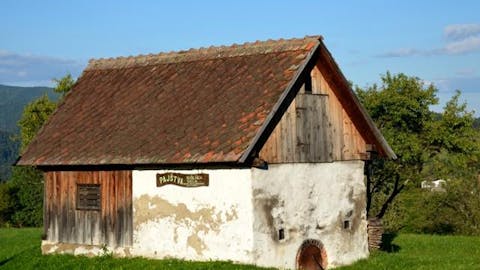
Lovrenc na Pohorju Municipality
Pajštva – Fruit Drying House
In Lovrenc there was an abundance of fruit, especially apples, pears, and plums. The locals dried part of the harvest and stored it for the winter months. To this day, a more than 100-year-old Pohorje pajštva (fruit drying house) has been preserved, where fruit and flax were dried. According to accounts of older locals, however, it is said to be more than two hundred years old.
The pajštva stands between the parish church of St. Lovrenc and the cemetery.
The building is 727 cm long and 337 cm wide. It is partly masonry, partly wooden, and the roof is covered with old tiles. The roof truss is constructed and joined without nails, using only wooden pegs or “cveki.” The interior is divided into two parts: an anteroom and the drying chamber. The drying chamber is built above a vaulted furnace and divided into left and right sections, each with three “dere” (wooden drying racks) at three different levels. The dere are wooden platforms on which the fruit was placed.
A particular feature of the pajštva is that the fruit was dried inside on the dere, while the fire was lit from the outside. The dere are mounted on wooden rollers (“valcni”) so they can be easily moved and adjusted to the desired height or closer to the source of heat, ensuring the fruit dried evenly. Pears and plums were dried whole, while apples were cut into quarters, which when dried were called platiči, and dried pears were called kloce.
The pajštva is an ethnological monument.
In the land register, the plot on which the pajštva stands is listed under number 139/4.
